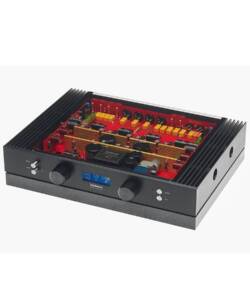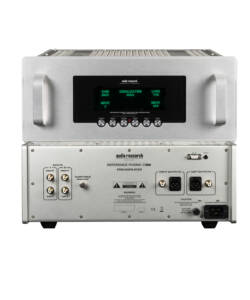Bryston BP-25 Preamplifier
Original price was: R58,000.00.R14,800.00Current price is: R14,800.00.
The Bryston BP-25MC preamplifier is a full-function control center with one balanced and four single-ended inputs, including one input for a moving-coil cartridge. The BP-25 is shielded in a black steel cabinet said to reduce electromagnetic interference effects. The power transformer is housed in a small external chassis, the BP-PS. The BP-25’s remote control allows volume up/down, along with buttons for mute and absolute polarity. Signal switching and audio connections, including balanced and unbalanced input and output connectors, are heavily gold-plated to provide good long-term connections. A 12V AC/DC screw terminal connector on the rear of the power supply provides convenient use when used in conjunction with the remote start feature optionally available on Bryston power amplifiers.

From left to right, front-panel controls include a Tape/Source toggle switch, the infrared sensor for the remote, and an MM Phono/MC Phono toggle switch. Next is a rotary control to select input sources, which includes settings for Bal 1, Bal 2, Phono, CD, Tuner, Video (for laserdisc), and Disc. At panel center is a rotary balance control. To the right of this is the motor-driven volume control, followed by toggle switches for Polarity/Invert and Mute/Normal. (These switches change settings each time they’re switched up or down-rather than muting, for example, only when Mute is pushed down.) The tricolor LED glows red when the preamplifier is not muted or inverting, yellow when non-muted and inverting, and red when muted.
The BP-25MC’s build quality and circuit layout are superb. Almost all components are directly mounted on the main system circuit board extending the full width and depth of the chassis. Signals from the unbalanced jacks travel from an input board to this main board via two large ribbon cables. The main board features solder mask and extensive component designators. A written table at pcb center bears the signatures of those installing the capacitors and semiconductors, and the date the system board was completed. Many individual components are used, including very-high-quality film capacitors in a number of places. Looking at the system board from above, I saw no point-to-point wiring.
The BP-25MC’s internal power supply—situated at the right when viewing the chassis from the front—seems to be rugged and well-designed. It employs a discrete bridge rectifier (four 1N4004 diodes) feeding two 4700µF electrolytics. Three 3-pin IC regulators are mounted on individual heatsinks, two of them (a 7824 and a 7924) supplying ±24V to the electrolytics, while the third (a 7808) supplies voltage for the logic to control muting on turn-on. Final filtration is accomplished on the low-voltage regulated side by 2200µF electrolytics. A separate source for the power-on muting system shorts all inputs until the preamplifier has settled. Additional 2200µF electrolytic capacitors provide further filtration at key points in the preamplifier, including the phono stage.
The BP-25MC’s built-in phono section occupies the left side of the chassis: two matching circuit areas, one per channel, run the depth of the chassis side by side. Two metal-shielded cans, transformers for the moving-coil input, sit just behind the front panel. (These transformers are identical to the company’s TF-1 outboard transformer.) The BP-25MC can be ordered with two different gain configurations: the higher configuration of 22.5dB gain, with the transformer wired in series; or 16.5dB gain, with the transformers wired in parallel for a lower source impedance. Behind the transformers sit two identical circuit boards for the moving-magnet cartridges, these including the RIAA equalization circuitry. Total gain for moving-coil cartridges at mid-frequency through the entire phono section of the BP-25MC is 56.5dB.
The line amplification for the BP-25MC is provided by operational amplifier chips, three per channel. Two of these op-amps are to buffer the signal to the tape output and level control, the remaining four for the two balanced outputs. These integrated circuits are specified as delivering high output with low noise. The high 24V rails supplying the op-amps mean that the preamp is relatively resistant to overload.

Listening to the BP-25MC
My interest in the Bryston BP-25MC preamplifier first centered on its remote control—it allowed me to adjust volume during casual listening sessions. This proved to be addictive, as my listening position was 12′ from the preamplifier. I soon discovered that the infrared sensor has a narrow angle of reception at that distance, and will not respond if signaled from more than 45 degrees off-axis. To make certain the preamp responded, I turned it so that one corner overhung the edge of the shelf. I also found that when the preamplifier was left on for long periods of time without use, it sometimes went into mute; the remote’s Mute and Phase pushbuttons then had to be cycled repeatedly to wake the BP-25MC from Mute.
Even with these minor frustrations, the Bryston BP-25MC proved to be a superb preamplifier for reviewing. The volume-control settings provided stable and reliable output, essential for product comparisons. When reviewing the D/A processors mentioned in the Sidebar, I made a light pencil-mark on the front panel next to the rotary volume control to record the approximate setting needed to produce the same voltage out (read by a multimeter) at the speaker terminals when playing a tone from a test CD. These settings produced the same voltage, within 100mV, each time the appropriate D/A processor was put into the system.
Initial impressions of the BP-25 MC, obtained by listening through its phono section, was that it leaned toward a warm, somewhat distant presentation with an open-sounding top end. As time went on, this sonic signature became clearer and more distinct, particularly in comparison with other preamplifiers at my disposal. With the Quad ESL-63s and Totem Model 1s, which emphasize midrange character, the BP-25 had a warm, smooth midrange. The Snell Type A Reference system revealed the preamp’s open, unrestrained top end.

The BP-25MC’s phono section was equally competent in the bass, reproducing 32Hz pipe-organ notes as well as the rhythmic drive and pace of the double-bass sections of orchestral music. This was evident in its accurate portrayal of the wide dynamic range and powerful orchestral rhythms found in Shostakovich’s Symphony 6 (Stokowski/CSO, RCA LSC-3133). Similarly, the BP-25MC equaled the ML-7A in reproducing the rhythmic drive of Bartók’s Concerto for Orchestra, as heard on Classic Records’ remastered LP of the original RCA recording (Fritz Reiner/CSO, LSC-1924). This firm, solid bass was also heard on “After Anthem,” from the LP of James Horner’s Glory soundtrack (Virgin ST-VR-897678, 1-91329). The full orchestra and the Boys Choir of Harlem presents a dense, colorful sonic fabric; the BP-25 MC conveyed a lovely, warm string tone and the full strength of the soprano voices without strain or distortion.
The BP-25MC’s midrange reproduction convincingly captured instrumental and vocal timbres. On “I Don’t Get Around Much Anymore,” from the When Harry Met Sally… soundtrack (Columbia CK 45319), Harry Connick, Jr.’s voice had just the right timbre without sounding tubby or nasal. On “Grandmother Song” (from The Raven, Chesky JD115), I heard Rebecca Pidgeon’s delicate soprano center-stage in a palpably three-dimensional sonic image. The piano placement on that recording—slightly behind and to the right of the singer—is eerily precise, and was depicted with equal precision by the BP-25MC and the ML-7A, as were the dynamics of Pidgeon’s voice. However, the ML-7A was slightly more transparent and more immediate, and did a better job of rendering the sweetness of that voice.
The Bryston BP-25MC captured the timbre of string instruments while playing two of my favorite excerpts from the chamber music literature. One is from the third movement of Haydn’s Quartet in d (“The Quinten”), recorded live by the Lindsay String Quartet (CD, ASV CD DCA 622). This movement features a canon with two violins playing together in octaves, followed three beats later by viola and cello; its driving tempo has earned it the nickname of “The Witches’ Minuet.” The music was greatly enhanced by the timbre of the instruments, the warmth of the viola and cello resonances, the tonalities of wood and bow, the sweetness of the violin strings.
This recording contains the usual ambient audience noise found in a live recording, including coughs and chair movements, which added to the hall ambience. The BP-25 MC gave a wider soundstage than the ML-7A, with the cello far to the left. The ML-7A, however, was more neutral, with clear delineation of instruments and space. The ‘7a also captured more timbre from the cello and viola, more sense of wood and bow. Violin string tone was equally sweet through either preamplifier.
The second piece—the Assai agitato of Schumann’s Quartet in A, Op.43 No.3 (Joachim Koeckert Quartet, Calig-Verlag CAL 50849)—showed that the Bryston BP-25MC was the ML-7A’s equal in capturing the rhythmic pace inherent in brilliant chamber music. The BP-25MC captured the dark, swirling torment of the L’istesso tempo section, and its preservation of natural string resonance was quite involving. Dynamics and good transient response were also evident with the BP-25 MC, as heard during the opening movement of Prokofiev’s Romeo and Juliet on the original direct-to-disc vinyl (Leinsdorf/LAPO, Sheffield Lab 8). Both the ML-7 and the BP-25 MC were able to capture the dynamics of “Romeo Resolves to Avenge Mercutio’s Death,” totally involving me. While the BP-25MC did a better job of creating the orchestra’s rhythmic drive, the ML-7A was somewhat better at conveying the width and depth of the orchestral sonic image, as well as its timbre.
The BP-25MC’s treble register was extended and neutral. Space was well depicted, almost equal to the ML-7A’s transparency and ability to reveal the sense of air around instruments. Generous soundstage depth and width were heard playing Holst’s Chaconne (Howard Dunn/Dallas Wind Symphony, Reference Recordings RR-39CD). Driven by Bryston 7B-STs or the ML-7A, the Snell Type A Reference System created a seamless choral fabric behind José Carreras, spread across the soundstage in the opening Kyrie of Misa Criolla (Philips 420 955-2, DDD). The spoken “Well done!” was perceived correctly over both preamplifiers at the extreme left stage, where it appears at the end of Anna Maria Stanczyk’s performance of Chopin’s Scherzo in b-flat, Op.31 (on Stereophile‘s first Test CD).
Overall, the BP-25MC proved to be fast and powerful, and excellent in bass response and soundstage presentation. In direct comparisons to the (discontinued) ML-7A, the $2995 BP-25MC lagged behind only in terms of transparency. However, it does have a remote control for the volume and an internal phono module that accepts low-output moving-coil cartridges, which the Levinson does not.
Summing up
The moving-coil features and its purist, low-profile chassis and outboard power source make the Bryston BP-25MC preamplifier perfect for the audiophile market. It is optimized for quiet operation to handle low-output moving-coil phono cartridges. I grew totally addicted to the remote-control options, so I warn you right now: If you take this preamp home as a loaner from your local audio dealer, you’ll buy it.

If you do, you won’t be disappointed—the BP-25MC has world-class bass response and a midrange that can capture much of the natural instrumental timbres of chamber and orchestral music. Bryston has done very well with the BP-25MC; I recommend it as a solid Class B product for any system.
Description
Specifications:
- Frequency response: 20Hz to 20kHz
- Total harmonic distortion: 0.0025%
- Input sensitivity: 500mV (line)
- Signal to noise ratio: 100dB (line)
- Output: 3V (Pre out), 15V (Pre out Max)
- Dimensions: 431.8 x 44.4 x 280mm
- Weight: 7.5kg






